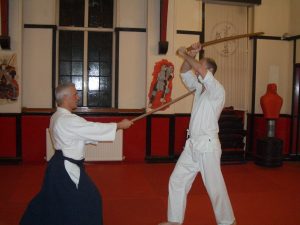The Dojo and Basic Etiquette:
Dojo……practice hall
 Traditional Style Dojo (Iwama, Japan)
Traditional Style Dojo (Iwama, Japan)
Tatami…practice mats
Kamiza….literally “spirit seat” – spiritual centre of dojo
 Kamiza
Kamiza
Onegai shimasu…..”please practice with me”
Domo Arigato Gosaimashita….thankyou very much (past tense)
Osu!….general term used as acknowledgement in dojo
Shomen….generally below kamiza, where founders picture is displayed
Rei…bow – Tachirei (standing), Zarei (kneeling)
Shomen ni rei…….bow to kamiza
Sensei ni rei….bow to sensei
Otegai ni rei…..bow to each other
Mokuso…………deep breathing meditation at beginning/end of class
Dogi……..training suit
Obi….belt
 Obi (correctly tied)
Obi (correctly tied)
Zori…….flip flop type footwear worn off the mat
Bokken….wooden sword
Jo….4ft staff
Tanto….wooden dagger
Preliminaries:
Kamae…..posture (general term)
Kamae nao rei……. posture for bowing, heels together
Hanmi….aikido stance
 Migi Hanmi no kamae
Migi Hanmi no kamae
Migi/Hidari…..right/left
Aihanmi…….mutual stance
Gyaku hanmi…….opposite stance
Seiza…. sitting on knees , literally “correct sitting”
 Seiza
Seiza
Seiza-ho….formal kneeling exercise
Shikko ho …..walking on the knees
Keiko….training
Wasa….techniques
Taiso……exercise
Ma-ai……correct practice distance
Sensei….teacher
Sempai…..senior student
Kohai…….junior student
Kyu……student grade/rank
Dan……black belt grade/rank
Shinsa….grading/test
Shite….person who performs the technique
Uke……person who receives the technique
Embu…..demonstration
 Embu
Embu
Shochu geiko…..special intensive training during hottest summer months
Kan geiko ….. similar training during coldest winter months, perhaps outdoors
Mitori geiko….watching practice e.g when injured
Hajime geiko ….intensive, fast practice based on a single technique
Basic Dojo Commands:
Hajime…..begin
Yame……stop
Seiza…….command to sit on your knees
Ki-o-tsuke…….stand to attention, be ready
Kiritsu……stand up
Ichi-ni-tsuki…….to your places
Sekkin……move towards each other in kamae, ready to perform a technique
Hontai gowa onajiku…perform technique on other side
Shite, uke kotai…….shite and uke change roles
Owarimasu……finished
Ichi, ni, san, shi, go , roku, shichi, hachi, ku, ju. …….numbers 1 to 10
Techniques and Exercises:
Kihon dosa…..basic movement exercises
 Kihon Dosa
Kihon Dosa
Tai no henka……body change
Hiriki no yosei……..Elbow power
Shumatsu dosa…after class exercise
Tandoku dosa….solo exercise
Sotai dosa…….paired exercise
Ken Suburi……solo cutting practice with wooden sword
Kihon wasa…..basic techniques
Oyo wasa….applied/advanced versions of techniques
Jiyu wasa…freeform techniques
Kaeshi waza….reversal technique
Henka wasa…. Technique which is changed during its application
Goshin wasa…..Self defence techniques
Ichitaita….one against many
 Ichi tai ita embu
Ichi tai ita embu
Kakarigeiko…….group practice
Shomenuchi….overhead strike
Shomentsuki….stepping thrust punch
Yokomenuchi……side strike with tegatana
Katate mochi…..wrist grab
Ryokata mochi…..both wrists grab
Ushiro wasa……rear technique
Tachi wasa….standing technique
Suwari wasa…….kneeling technique
Nage….throw
Osae…..pin or immobilsation
Ikkajo/Nikkajo/Sankajo/Yonkajo….four basic pinning techniques
Shihonage……..four direction throw (fundamental aikido technique)
Tenchi nage……heaven and earth throw
Kokyunage….breath throw
Hiji Jime ………elbow lock
 Hiji Jime
Hiji Jime
Ude Garame ……arm entanglement
Irimi……entering
Sokumen Irimi….diagonal entering
Jushin no ido……rotation of the hips
Chushin Ryoku……power derived from a strong centre-line
Shuchu Ryoku……focused power
Kokyu Ryoku…….breath power
Zentai Ryoku…….. whole body power
Tachi/Jo/Tanto dori….technique for taking weapon from armed attacker
Kumi Tachi…..paired sword practice movements
 Kumi Tachi
Kumi Tachi
Tanto soho….solo or paired tanto movements
Some More General Budo Terms:
Budo …….. The Way of the Warrior, a term applicable to many Japanese martial arts, Aikido included.
Soji ………. Cleaning the dojo, an important part of budo training
Hara ……… Mid part of the body (hips, belly, lower back) centre of movement and focus of concentration.
Suki ………. An opening in ones defenses, maybe due to poor posture or awareness
Shikaku …….”Dead Zone”, point at which uke’s balance is best taken.
Sen ………… Initiative in a confrontation
Sasoi ………. Inviting an attack in order to control the confrontation
Gokui……….. The essence or special point of a technique
Kata ……….. Predetermined sequence of movements for training. Yoshinkan kihon wasa techniques are performed as kata.
Shugyo…….. Long term arduous training undertaken by serious budoka, training of the spirit.
Kan ………… Intuition/Perception, said to be the result of prolonged and dedicated shugyo.
Ichi-go ichi-e…”one meeting, one chance”, focusing of all powers on the present moment.
Shoshin……… “Beginners mind”, a mind open to learning, all budoka should retain this.
Seishin Tanren ..Forging of the spirit through budo training
Zanshin……….”Lingering awareness” following a technique
The Constituent Parts of a Yoshinkan Technique (for understanding dojo commands):
- The Attack
- The Technique Name
- Pin (Osae) or Throw (Nage)
- Entering (when pulled) -“Ichi “, or Turning (when pushed) – “Ni”.
Example : Shomenuchi (overhead strike) – Nikkajo (wrist control) – Osae (pin) – Ichi (entering technique)
